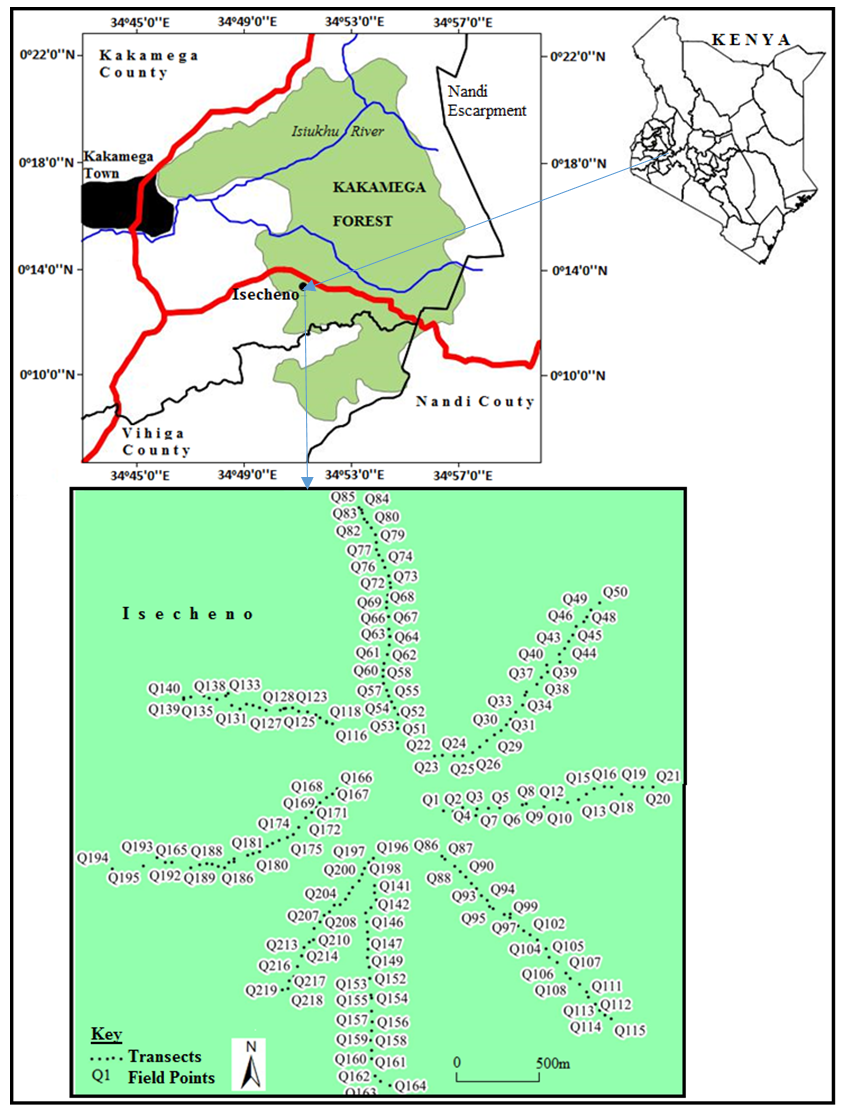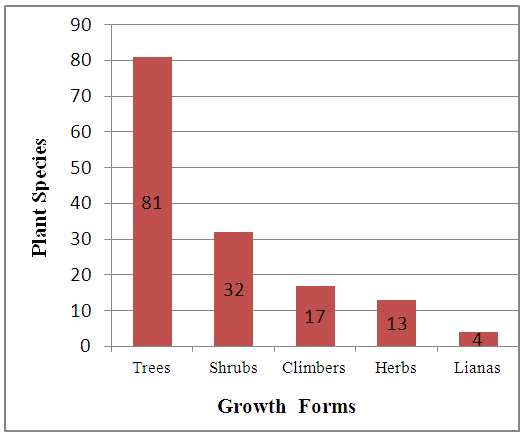-
Paper Information
- Next Paper
- Paper Submission
-
Journal Information
- About This Journal
- Editorial Board
- Current Issue
- Archive
- Author Guidelines
- Contact Us
International Journal of Agriculture and Forestry
p-ISSN: 2165-882X e-ISSN: 2165-8846
2018; 8(2): 70-76
doi:10.5923/j.ijaf.20180802.04

Current Floristic Composition and Growth Forms of Equatorial Rainforest, Kakamega County, Kenya
Fred Seswa , Shyam Manohar, Esther Kitur
Department of Environmental Science, Kenyatta University, Nairobi, Kenya
Correspondence to: Fred Seswa , Department of Environmental Science, Kenyatta University, Nairobi, Kenya.
| Email: |  |
Copyright © 2018 by the authors and Scientific & Academic Publishing.
This work is licensed under the Creative Commons Attribution International License (CC BY).
http://creativecommons.org/licenses/by/4.0/

Floristic composition and growth forms were studied in central Isecheno nature reserve part of the main tropical rainforest using transects and systematic quadrats following compass direction from January to December, 2014. Totals of 8 transect and 219 quadrats of 10m by 10m each were studied. There are 57 families represented by 124 genera composed of 146 plant species. The present composition/ inventory of plant species was recorded: Family Euphorbiaceae has maximum number of 13 species; sub-dominant families are Moraceae and Rubiaceae with 11 species each; Acanthaceae and Fabaceae families have 5 species each; Bignoniaceae family is represented by 4 species; Mimosaceae, Piperaceae, Rosaceae, Boraginaceae and Verbenaceae families represents only 3 species each; Apocynaceae, Asclepediaceae, Celastraceae, Dracaenaceae, Menispermaceae, Myrtaceae and Oleaceae families are represented only by 2 species each and 33 families are represented only by single species which reflects on poor species composition due to heavy pressure of human population to utilize resources. Five types of growth forms are present and represented by 55.48% trees, 21.94% shrubs, 8.9% herbs, 16% climbers and only 2.74% lianas. Based on the present composition/inventory of this forest, it is concluded that this equatorial forest of Kenya is under serious threat, many species have been extinct and many others are endangered.
Keywords: Floristic composition, Growth forms, Isecheno nature reserve
Cite this paper: Fred Seswa , Shyam Manohar, Esther Kitur , Current Floristic Composition and Growth Forms of Equatorial Rainforest, Kakamega County, Kenya, International Journal of Agriculture and Forestry, Vol. 8 No. 2, 2018, pp. 70-76. doi: 10.5923/j.ijaf.20180802.04.
Article Outline
1. Introduction
- Floristic composition is the part of an inventory of any natural ecosystem composed of taxonomic and species diversity which indicates the genetic diversity of equatorial rainforest of Kakamega as a high biodiversity area with unique plants and animals [14]. Total composition or inventory states the level of degradation and also the impacts on specific species which gives us clue to plan and manage endangered and extinct species of this resources by use of biotechnological methods. Each growth forms provides suitable habitat for several plants and animal species within an ecosystem. It plays a significant role in maintaining the surrounding physical environment. Globally rainforests provide habitats for more than 5 million plant and animal species and this resource was depleted at an estimated rate of between 1-2 percent per year, since human civilization present rate of depletion has increased up to 11 percent per year. During this 21st century knowledge about the structure, composition, dynamics and taxonomy diversity of tropical rainforest has not yet been studied completely. Forest stabilize the world’s climate and serves as water catchment areas, biological diversity of medicinal plants, perfumes, home for wild animals and ancestors of many crops, source of genetic materials, fruits, resins, lignin, gums, rubber and carbon sinks. Therefore, conservation and management of forest and their diversity is the most important objective for the national and international forest management policies or laws. In the past the total area of equatorial rainforest of Kakamega was approximately 24,598 hectares but during 1967 about 13,500 hectares of indigenous equatorial rainforest was left out signifying that about 11.098 hectares is degraded due to human activities [14]. During the same period Isecheno nature reserves measuring 295 hectares and Yala nature reserves about 460 hectares were created within this tropical rainforest [4]. The main objective was to protect the rainforest area from overharvesting therefore it was divided to preserve the different forest sections of equatorial rainforest of Kakamega. However, before independence the nature reserves were affected by selective logging by local population and it was estimated that 20-30 percent of the stems had been cleared in the sub-canopy layer [8]. The previous studies of floristic composition of Kakamega tropical rainforest and its fragments presents 370 plant species [10], 213 plant species [3] and 397 species of plants comprising of 112 trees species, 62 shrub species, 58 climber species, 141 herbs species and 24 ferns species [2]. Change in floristic composition is a key challenge for ecologists, bio-geographers and resource managers [6, 15]. Therefore, for effective conservation of any ecosystem is important to understand its past and current floristic composition.
2. Material and Methods
2.1. Description of Study Area
- Floristic composition which was studied in central Isecheno nature reserve covers about 295 hectares part of equatorial/tropical rainforest located at Latitudes 0o 19' N and Longitudes 34o 52' E; between 1574-1623 metres above the sea level in Kakamega County at the distance of 425 km North-West from the capital city Nairobi, (Kenya) (Figure 1).
 | Figure 1. Map of the Study area showing locations and distribution of Eight transects and 219 quadrats used to collect plant species within Isecheno section of rainforest of Kakamega, Kenya |
2.2. Data Collection and Analysis
- An extensive vegetation survey was carried out during the study period using systematic sampling according to [9, 13] to study floristic composition by use of transects and quadrats methods. Sampling quadrats were arranged along eight transect, each starting from the peripheral of the Kalunya glade in the core of the forest following the compass direction of (E, NE, N, NE, N, NW, W, SW, S, SE) to the edge of forest adjacent to the tea plantation (Figure 1). the starting point and the end point of each transect line and each quadrat site were recorded using a GPS and it was visualized in Arc view 3.X to allow way points to be relocated in the future. Each of the eight transects contain different number of 10m by 10m (100m2) quadrats. The first quadrat was placed at 5m from the edge of the glade and more quadrats were laid down along the line of transects at an interval of 50m from each other so that maximum variations could be recorded. Species occurring within 10m radius from the quadrats boundaries were also recorded for floristic composition. In total 219 quadrats were studied for sampling. All angiospermae plants available in the study area were identified in the field, each specimen collected, pressed, dried and mounted on standard sheets for further identification. The plant species that could not be identified in the field, their specimen were taken to the herbarium section of the national museum of Kenya for identification using previous collection. The growth forms of all vascular plants were identified, determined and classified according to [1, 3, 5, 11, 12]. A complete checklist of angiospermae plant species representing trees, shrubs, herbs, climbers and lianas was made systematically selected quadrats along each transect.
3. Results and Discussions
3.1. Floristic Composition
- The total number of 146 plant species belonging to 124 genera and 57 families were identified in the study area. The families with respect to number of species in the study area were Euphorbiaceae family represented by 13 species; Moraceae and Rubiaceae with 11 species each; Acanthaceae and Fabaceae with 7 species each; Rutaceae has 6 species; Sapotaceae, Flacourticeae, Meliaceae, Sapindaceae and Ulmaceae has 5 species each; Bignoniaceae is represented by 4 species; Mimosaceae, Piperaceae, Rosaceae, Boraginaceae and Verbenaceae represents only 3 species each; Apocynaceae, Asclepediaceae, Celastraaceae, Dracaenaceae, Menispermaceae, Myrtaceae and Oleaceae are representedby 2 species each whereas 33 families namely Adiantaceae, Alangiaceae, Anacardiaceae, Annonaceae, Araliaceae, Balsaminaceae, Basellaceae, Caparaceae, Commelineceae, Cucurbitaceae, Dennistaedtiaceae, Dryopteridaceae, Ebenaceae, Gutiferae, melianthaceae, Musaceae, Myrsinaceae, Nyctaginaceae, Olacaceae, Orchidaceae, Poaceae, Passifloraceae, pittosporaceae, Plantaginaceae, Rhamnaceae, Rhizophoraceae, Solanaceae, Sterculiaceae, Theaceae, Urticaceae, Vitaceae and Zingiberaceae have only 1 species. It is noticed that 54% of the families are represented by only one species each, it shows that floristic composition is poor due to human activities. Species richness per family supports forest ecosystem against severe depletion in case of degradation. Loss of such plant species not only implies the native extinction of the family and its genera but also complete interference with forest ecosystem parallel and cyclic configuration processes undertaken by such plant species. The high rpresentation of Euphorbiaceae family mostly found in marginal areas is an indication that Kakamega forest is highly disturbed. [7, 14] documented similar floristic composition. (Table 1 & Figure 2).
|
 | Figure 2. Bar diagram shows plant families comprising the number the number of species in the rain forest of Kenya (Jan-Dec 2014) |
3.2. Growth Forms
- Based on the height, growth and nature of plant species only five growth forms are present in Isecheno nature reserve; (i) 81 trees (ii) 32 shrubs (iii) 13 herbs (iv) 16 climbers and (v) 4 lianas. (Figure 3). It is noticed that there are 55.48% trees, 21.92% shrubs, 8.9% herbs, 16% climbers and only 2.74% lianas.
 | Figure 3. Bar diagram shows growth forms of plant species studied within Isecheno section of rainforest situated in western part of Kenya |
4. Conclusions and Recommendations
- The present study represents the first comprehensive floristic composition and growth forms of Isecheno nature reserve part of the main tropical rainforest of Kakamega. In this forest with economically and ecologically important plants, there are 57 families, 124 genus and 146 plant species. At the moment 57.89% families are represented by only one genus that indicates significant loss of taxonomic and genetic diversity due to selective harvesting of specific plant species by human population accessing this nature reserve. The study also reveals five types of growth forms made up of 81 trees, 32 shrubs, 13 herbs, 16 climbers and 4 lianas. The edge of the forest which is easily accessible by local population is planted by tea and sugar cane. This is disrupting floristic composition in Isecheno nature reserve dominated by members of Euphorbiaceae family which normally grow in marginal areas.This inventory of floristic composition and growth forms is vital as a baseline to evaluate trends of each species and in follow up studies to determine change particularly after mitigation measures have been put in place. Therefore, it is important to keep updated records of floristic composition so that the inventory will reflect on each species to provide proper attention to measure impacts, plan, conserve and sustainable management depending on the species frequence, dominance, endangered and extinct species to improve protection within the nature reserve using bio-technological methods.
ACKNOWLEDGEMENTS
- We convey our sincere gratitude to the staff of Kakamega forest especially research assistants for their time and experience in assisting in field work without which would have been impossible to collect data. We also acknowledge the staff of National Herbarium, Kenya, for their kind assistance during specimen identification.
 Abstract
Abstract Reference
Reference Full-Text PDF
Full-Text PDF Full-text HTML
Full-text HTML